Organisational Behaviour: Culture, Teams and Motivation Analysis
VerifiedAdded on 2023/01/12
|15
|3468
|293
Report
AI Summary
This report delves into the intricacies of organisational behaviour, examining the influence of culture, politics, and power on both team and individual performance within an organisation, using Sainsbury's as a case study. It explores the impact of different cultural types and power dynamics on employee behaviour and decision-making. The report then analyzes motivation theories, including Maslow's hierarchy of needs and Vroom's expectancy theory, to understand how organisations can effectively motivate their employees. Furthermore, it differentiates between effective and ineffective teams, highlighting characteristics of each, and applies Tuckman's team development model to understand team stages. The report concludes by applying these concepts to real-world business situations, providing a comprehensive overview of organisational behaviour principles and their practical applications.
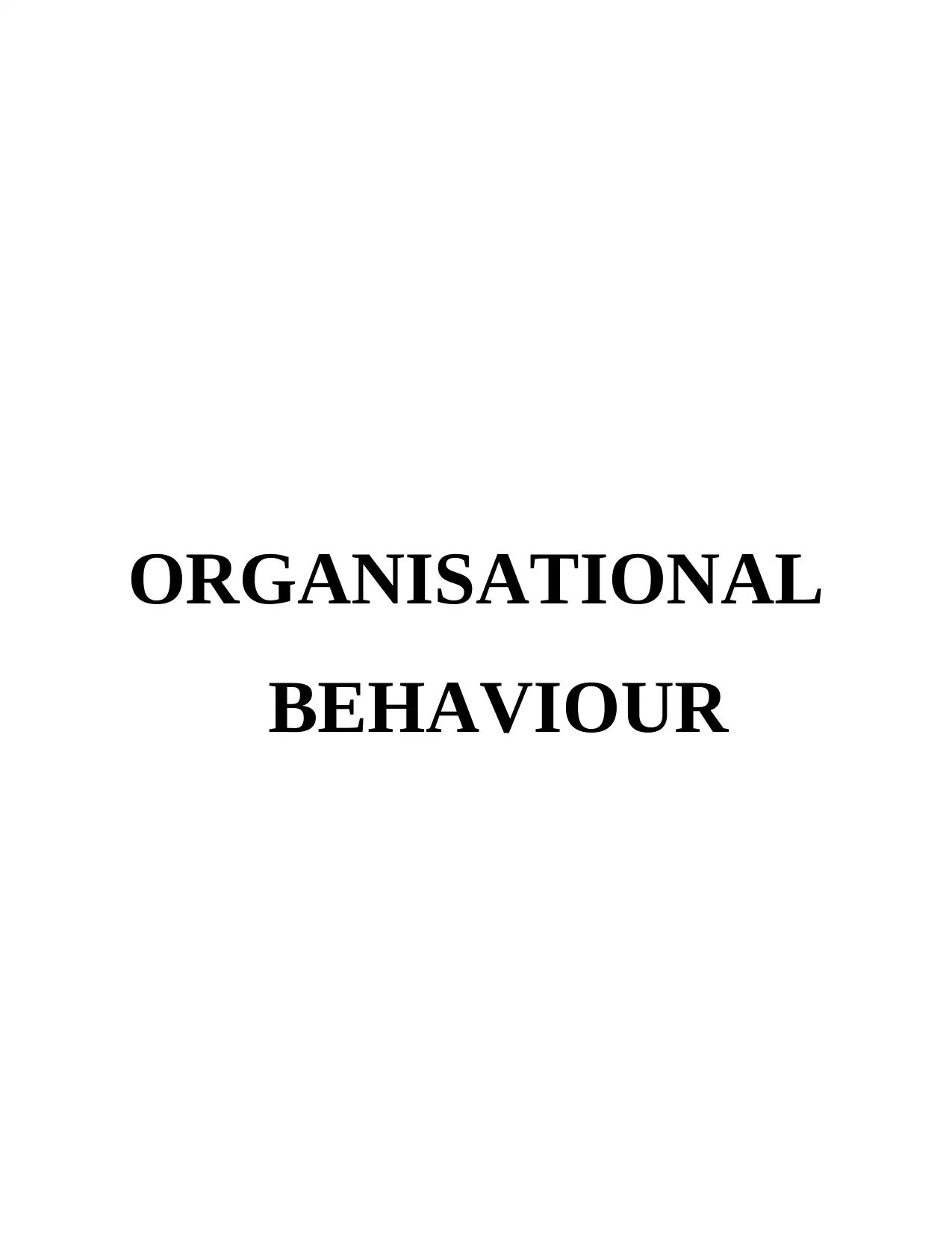
ORGANISATIONAL
BEHAVIOUR
BEHAVIOUR
Paraphrase This Document
Need a fresh take? Get an instant paraphrase of this document with our AI Paraphraser
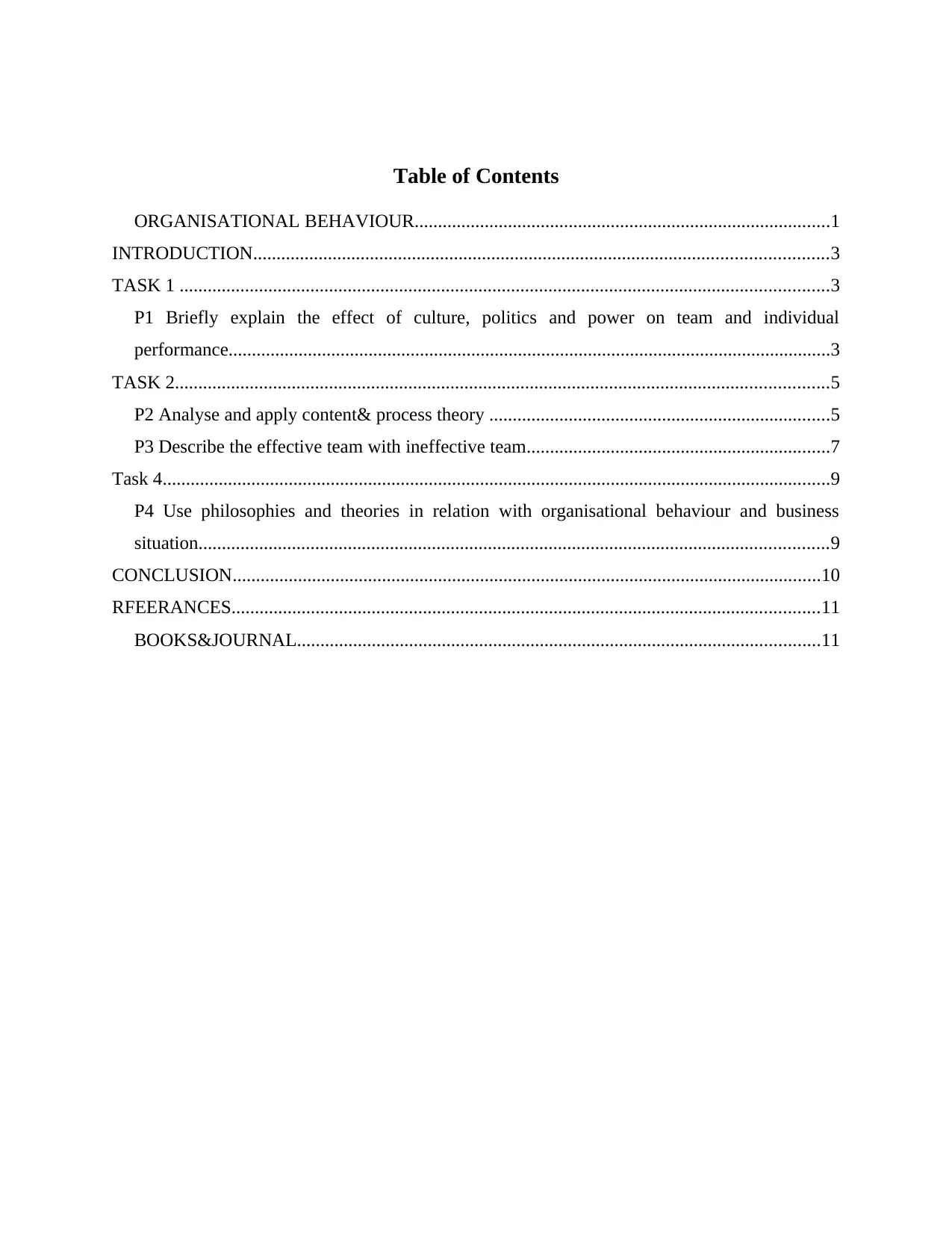
Table of Contents
ORGANISATIONAL BEHAVIOUR.........................................................................................1
INTRODUCTION...........................................................................................................................3
TASK 1 ...........................................................................................................................................3
P1 Briefly explain the effect of culture, politics and power on team and individual
performance.................................................................................................................................3
TASK 2............................................................................................................................................5
P2 Analyse and apply content& process theory .........................................................................5
P3 Describe the effective team with ineffective team.................................................................7
Task 4...............................................................................................................................................9
P4 Use philosophies and theories in relation with organisational behaviour and business
situation.......................................................................................................................................9
CONCLUSION..............................................................................................................................10
RFEERANCES..............................................................................................................................11
BOOKS&JOURNAL................................................................................................................11
ORGANISATIONAL BEHAVIOUR.........................................................................................1
INTRODUCTION...........................................................................................................................3
TASK 1 ...........................................................................................................................................3
P1 Briefly explain the effect of culture, politics and power on team and individual
performance.................................................................................................................................3
TASK 2............................................................................................................................................5
P2 Analyse and apply content& process theory .........................................................................5
P3 Describe the effective team with ineffective team.................................................................7
Task 4...............................................................................................................................................9
P4 Use philosophies and theories in relation with organisational behaviour and business
situation.......................................................................................................................................9
CONCLUSION..............................................................................................................................10
RFEERANCES..............................................................................................................................11
BOOKS&JOURNAL................................................................................................................11
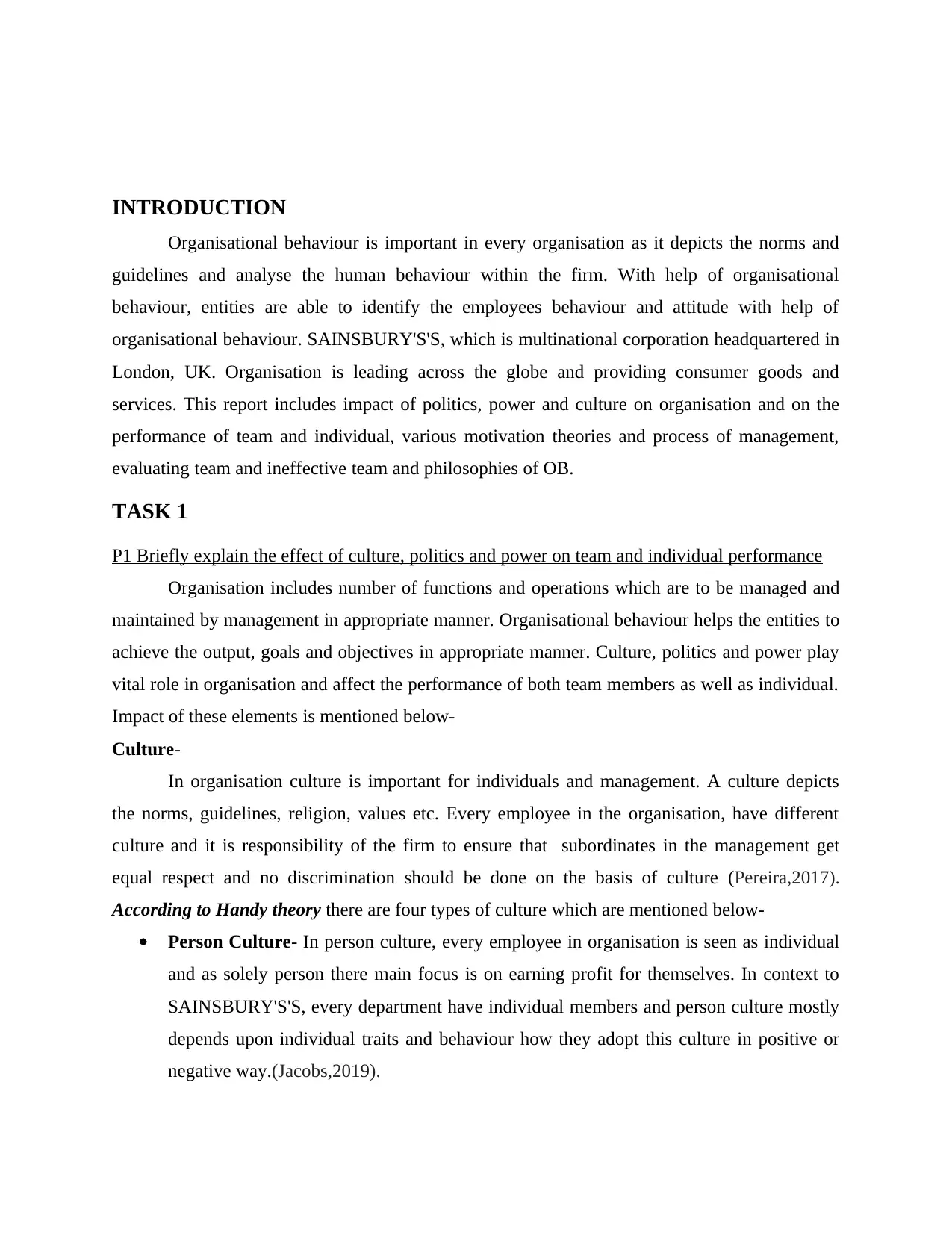
INTRODUCTION
Organisational behaviour is important in every organisation as it depicts the norms and
guidelines and analyse the human behaviour within the firm. With help of organisational
behaviour, entities are able to identify the employees behaviour and attitude with help of
organisational behaviour. SAINSBURY'S'S, which is multinational corporation headquartered in
London, UK. Organisation is leading across the globe and providing consumer goods and
services. This report includes impact of politics, power and culture on organisation and on the
performance of team and individual, various motivation theories and process of management,
evaluating team and ineffective team and philosophies of OB.
TASK 1
P1 Briefly explain the effect of culture, politics and power on team and individual performance
Organisation includes number of functions and operations which are to be managed and
maintained by management in appropriate manner. Organisational behaviour helps the entities to
achieve the output, goals and objectives in appropriate manner. Culture, politics and power play
vital role in organisation and affect the performance of both team members as well as individual.
Impact of these elements is mentioned below-
Culture-
In organisation culture is important for individuals and management. A culture depicts
the norms, guidelines, religion, values etc. Every employee in the organisation, have different
culture and it is responsibility of the firm to ensure that subordinates in the management get
equal respect and no discrimination should be done on the basis of culture (Pereira,2017).
According to Handy theory there are four types of culture which are mentioned below-
Person Culture- In person culture, every employee in organisation is seen as individual
and as solely person there main focus is on earning profit for themselves. In context to
SAINSBURY'S'S, every department have individual members and person culture mostly
depends upon individual traits and behaviour how they adopt this culture in positive or
negative way.(Jacobs,2019).
Organisational behaviour is important in every organisation as it depicts the norms and
guidelines and analyse the human behaviour within the firm. With help of organisational
behaviour, entities are able to identify the employees behaviour and attitude with help of
organisational behaviour. SAINSBURY'S'S, which is multinational corporation headquartered in
London, UK. Organisation is leading across the globe and providing consumer goods and
services. This report includes impact of politics, power and culture on organisation and on the
performance of team and individual, various motivation theories and process of management,
evaluating team and ineffective team and philosophies of OB.
TASK 1
P1 Briefly explain the effect of culture, politics and power on team and individual performance
Organisation includes number of functions and operations which are to be managed and
maintained by management in appropriate manner. Organisational behaviour helps the entities to
achieve the output, goals and objectives in appropriate manner. Culture, politics and power play
vital role in organisation and affect the performance of both team members as well as individual.
Impact of these elements is mentioned below-
Culture-
In organisation culture is important for individuals and management. A culture depicts
the norms, guidelines, religion, values etc. Every employee in the organisation, have different
culture and it is responsibility of the firm to ensure that subordinates in the management get
equal respect and no discrimination should be done on the basis of culture (Pereira,2017).
According to Handy theory there are four types of culture which are mentioned below-
Person Culture- In person culture, every employee in organisation is seen as individual
and as solely person there main focus is on earning profit for themselves. In context to
SAINSBURY'S'S, every department have individual members and person culture mostly
depends upon individual traits and behaviour how they adopt this culture in positive or
negative way.(Jacobs,2019).
⊘ This is a preview!⊘
Do you want full access?
Subscribe today to unlock all pages.

Trusted by 1+ million students worldwide
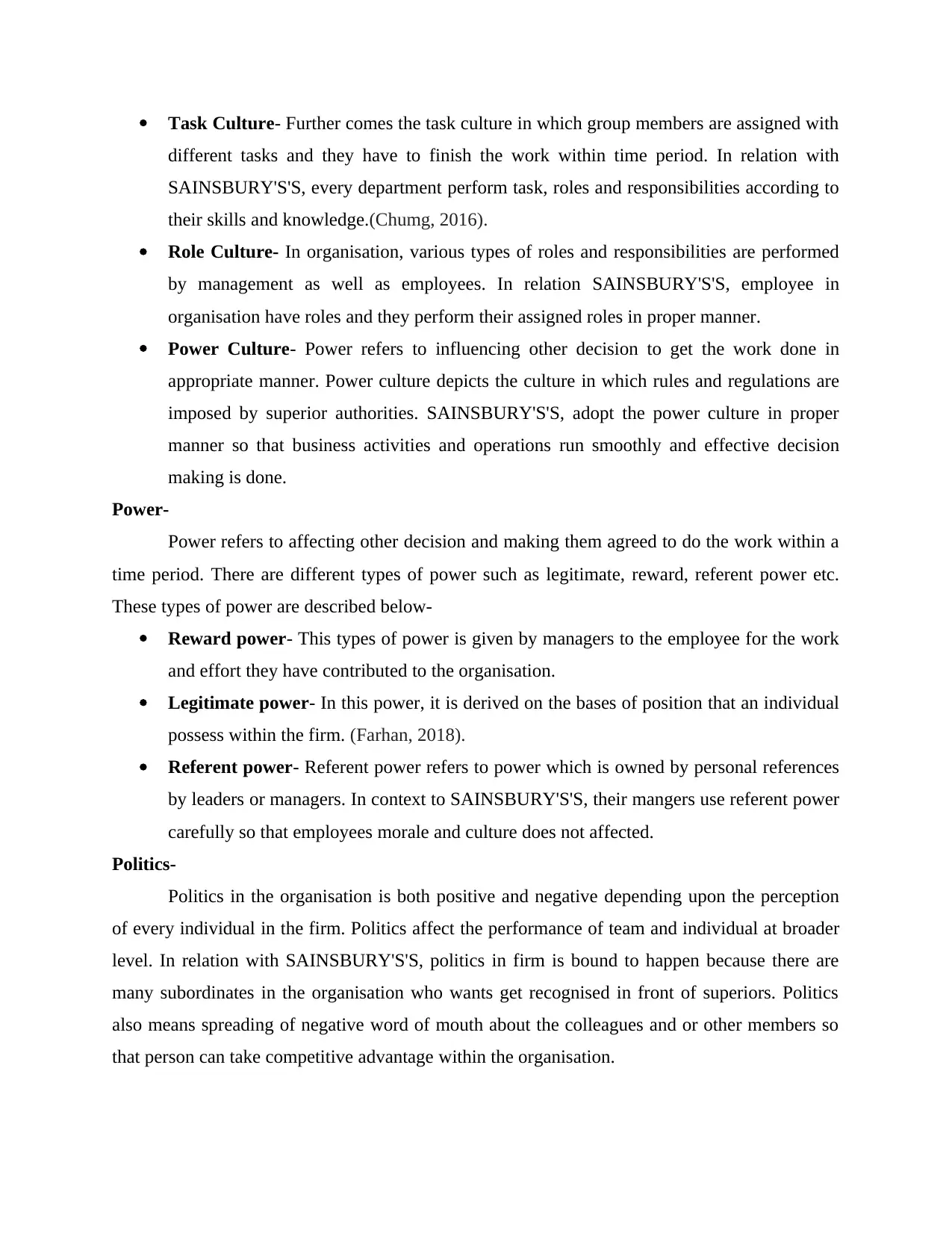
Task Culture- Further comes the task culture in which group members are assigned with
different tasks and they have to finish the work within time period. In relation with
SAINSBURY'S'S, every department perform task, roles and responsibilities according to
their skills and knowledge.(Chumg, 2016).
Role Culture- In organisation, various types of roles and responsibilities are performed
by management as well as employees. In relation SAINSBURY'S'S, employee in
organisation have roles and they perform their assigned roles in proper manner.
Power Culture- Power refers to influencing other decision to get the work done in
appropriate manner. Power culture depicts the culture in which rules and regulations are
imposed by superior authorities. SAINSBURY'S'S, adopt the power culture in proper
manner so that business activities and operations run smoothly and effective decision
making is done.
Power-
Power refers to affecting other decision and making them agreed to do the work within a
time period. There are different types of power such as legitimate, reward, referent power etc.
These types of power are described below-
Reward power- This types of power is given by managers to the employee for the work
and effort they have contributed to the organisation.
Legitimate power- In this power, it is derived on the bases of position that an individual
possess within the firm. (Farhan, 2018).
Referent power- Referent power refers to power which is owned by personal references
by leaders or managers. In context to SAINSBURY'S'S, their mangers use referent power
carefully so that employees morale and culture does not affected.
Politics-
Politics in the organisation is both positive and negative depending upon the perception
of every individual in the firm. Politics affect the performance of team and individual at broader
level. In relation with SAINSBURY'S'S, politics in firm is bound to happen because there are
many subordinates in the organisation who wants get recognised in front of superiors. Politics
also means spreading of negative word of mouth about the colleagues and or other members so
that person can take competitive advantage within the organisation.
different tasks and they have to finish the work within time period. In relation with
SAINSBURY'S'S, every department perform task, roles and responsibilities according to
their skills and knowledge.(Chumg, 2016).
Role Culture- In organisation, various types of roles and responsibilities are performed
by management as well as employees. In relation SAINSBURY'S'S, employee in
organisation have roles and they perform their assigned roles in proper manner.
Power Culture- Power refers to influencing other decision to get the work done in
appropriate manner. Power culture depicts the culture in which rules and regulations are
imposed by superior authorities. SAINSBURY'S'S, adopt the power culture in proper
manner so that business activities and operations run smoothly and effective decision
making is done.
Power-
Power refers to affecting other decision and making them agreed to do the work within a
time period. There are different types of power such as legitimate, reward, referent power etc.
These types of power are described below-
Reward power- This types of power is given by managers to the employee for the work
and effort they have contributed to the organisation.
Legitimate power- In this power, it is derived on the bases of position that an individual
possess within the firm. (Farhan, 2018).
Referent power- Referent power refers to power which is owned by personal references
by leaders or managers. In context to SAINSBURY'S'S, their mangers use referent power
carefully so that employees morale and culture does not affected.
Politics-
Politics in the organisation is both positive and negative depending upon the perception
of every individual in the firm. Politics affect the performance of team and individual at broader
level. In relation with SAINSBURY'S'S, politics in firm is bound to happen because there are
many subordinates in the organisation who wants get recognised in front of superiors. Politics
also means spreading of negative word of mouth about the colleagues and or other members so
that person can take competitive advantage within the organisation.
Paraphrase This Document
Need a fresh take? Get an instant paraphrase of this document with our AI Paraphraser
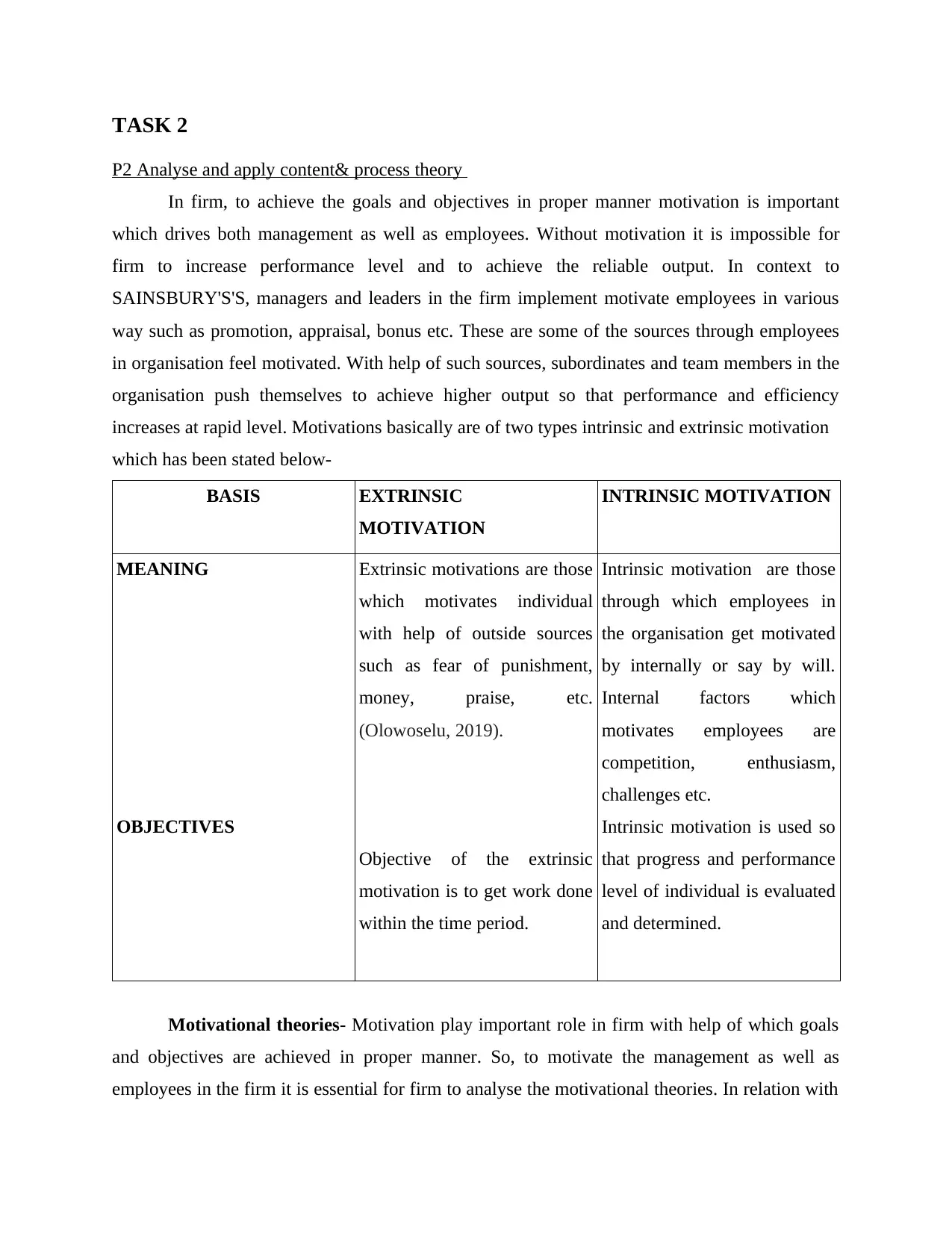
TASK 2
P2 Analyse and apply content& process theory
In firm, to achieve the goals and objectives in proper manner motivation is important
which drives both management as well as employees. Without motivation it is impossible for
firm to increase performance level and to achieve the reliable output. In context to
SAINSBURY'S'S, managers and leaders in the firm implement motivate employees in various
way such as promotion, appraisal, bonus etc. These are some of the sources through employees
in organisation feel motivated. With help of such sources, subordinates and team members in the
organisation push themselves to achieve higher output so that performance and efficiency
increases at rapid level. Motivations basically are of two types intrinsic and extrinsic motivation
which has been stated below-
BASIS EXTRINSIC
MOTIVATION
INTRINSIC MOTIVATION
MEANING
OBJECTIVES
Extrinsic motivations are those
which motivates individual
with help of outside sources
such as fear of punishment,
money, praise, etc.
(Olowoselu, 2019).
Objective of the extrinsic
motivation is to get work done
within the time period.
Intrinsic motivation are those
through which employees in
the organisation get motivated
by internally or say by will.
Internal factors which
motivates employees are
competition, enthusiasm,
challenges etc.
Intrinsic motivation is used so
that progress and performance
level of individual is evaluated
and determined.
Motivational theories- Motivation play important role in firm with help of which goals
and objectives are achieved in proper manner. So, to motivate the management as well as
employees in the firm it is essential for firm to analyse the motivational theories. In relation with
P2 Analyse and apply content& process theory
In firm, to achieve the goals and objectives in proper manner motivation is important
which drives both management as well as employees. Without motivation it is impossible for
firm to increase performance level and to achieve the reliable output. In context to
SAINSBURY'S'S, managers and leaders in the firm implement motivate employees in various
way such as promotion, appraisal, bonus etc. These are some of the sources through employees
in organisation feel motivated. With help of such sources, subordinates and team members in the
organisation push themselves to achieve higher output so that performance and efficiency
increases at rapid level. Motivations basically are of two types intrinsic and extrinsic motivation
which has been stated below-
BASIS EXTRINSIC
MOTIVATION
INTRINSIC MOTIVATION
MEANING
OBJECTIVES
Extrinsic motivations are those
which motivates individual
with help of outside sources
such as fear of punishment,
money, praise, etc.
(Olowoselu, 2019).
Objective of the extrinsic
motivation is to get work done
within the time period.
Intrinsic motivation are those
through which employees in
the organisation get motivated
by internally or say by will.
Internal factors which
motivates employees are
competition, enthusiasm,
challenges etc.
Intrinsic motivation is used so
that progress and performance
level of individual is evaluated
and determined.
Motivational theories- Motivation play important role in firm with help of which goals
and objectives are achieved in proper manner. So, to motivate the management as well as
employees in the firm it is essential for firm to analyse the motivational theories. In relation with
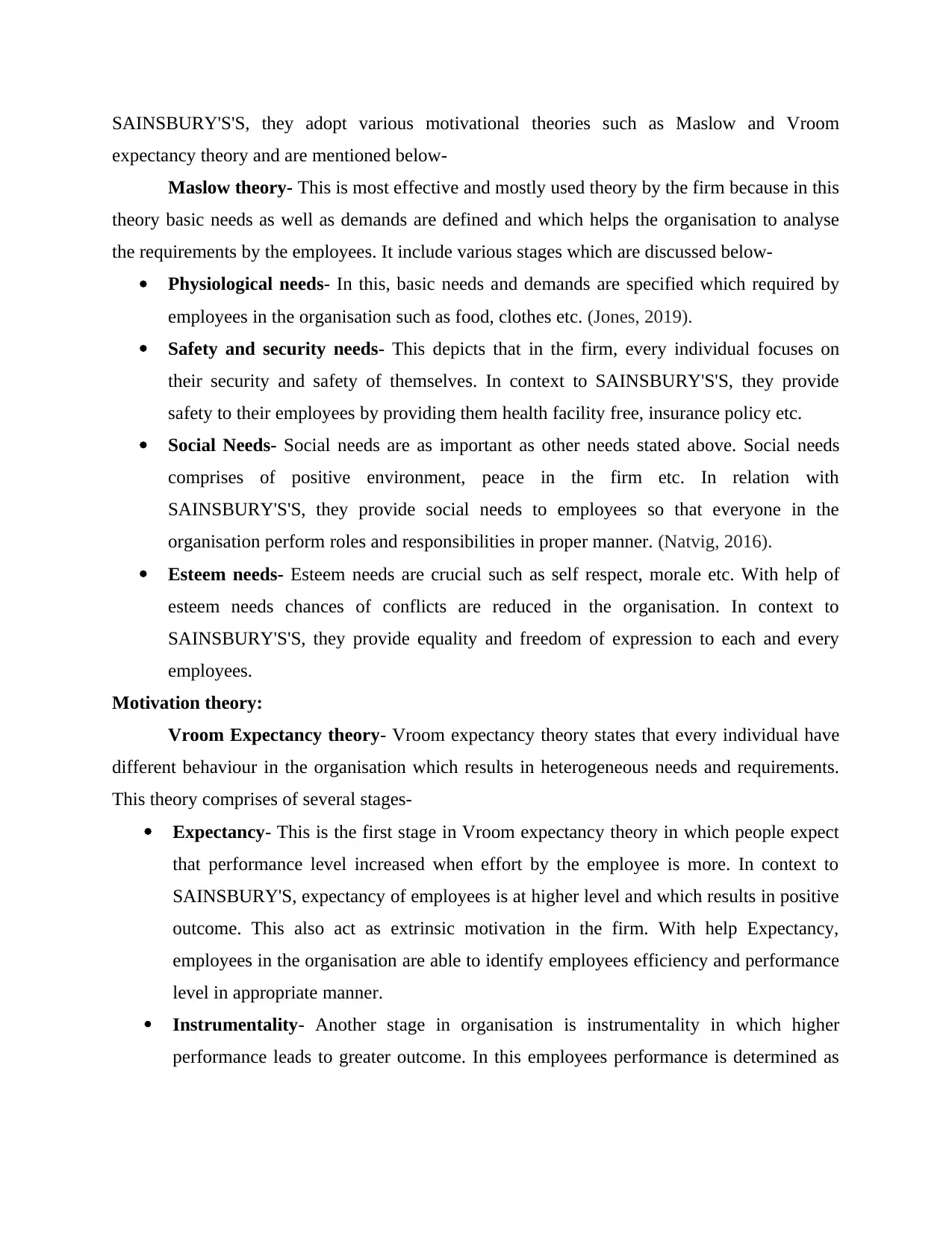
SAINSBURY'S'S, they adopt various motivational theories such as Maslow and Vroom
expectancy theory and are mentioned below-
Maslow theory- This is most effective and mostly used theory by the firm because in this
theory basic needs as well as demands are defined and which helps the organisation to analyse
the requirements by the employees. It include various stages which are discussed below-
Physiological needs- In this, basic needs and demands are specified which required by
employees in the organisation such as food, clothes etc. (Jones, 2019).
Safety and security needs- This depicts that in the firm, every individual focuses on
their security and safety of themselves. In context to SAINSBURY'S'S, they provide
safety to their employees by providing them health facility free, insurance policy etc.
Social Needs- Social needs are as important as other needs stated above. Social needs
comprises of positive environment, peace in the firm etc. In relation with
SAINSBURY'S'S, they provide social needs to employees so that everyone in the
organisation perform roles and responsibilities in proper manner. (Natvig, 2016).
Esteem needs- Esteem needs are crucial such as self respect, morale etc. With help of
esteem needs chances of conflicts are reduced in the organisation. In context to
SAINSBURY'S'S, they provide equality and freedom of expression to each and every
employees.
Motivation theory:
Vroom Expectancy theory- Vroom expectancy theory states that every individual have
different behaviour in the organisation which results in heterogeneous needs and requirements.
This theory comprises of several stages-
Expectancy- This is the first stage in Vroom expectancy theory in which people expect
that performance level increased when effort by the employee is more. In context to
SAINSBURY'S, expectancy of employees is at higher level and which results in positive
outcome. This also act as extrinsic motivation in the firm. With help Expectancy,
employees in the organisation are able to identify employees efficiency and performance
level in appropriate manner.
Instrumentality- Another stage in organisation is instrumentality in which higher
performance leads to greater outcome. In this employees performance is determined as
expectancy theory and are mentioned below-
Maslow theory- This is most effective and mostly used theory by the firm because in this
theory basic needs as well as demands are defined and which helps the organisation to analyse
the requirements by the employees. It include various stages which are discussed below-
Physiological needs- In this, basic needs and demands are specified which required by
employees in the organisation such as food, clothes etc. (Jones, 2019).
Safety and security needs- This depicts that in the firm, every individual focuses on
their security and safety of themselves. In context to SAINSBURY'S'S, they provide
safety to their employees by providing them health facility free, insurance policy etc.
Social Needs- Social needs are as important as other needs stated above. Social needs
comprises of positive environment, peace in the firm etc. In relation with
SAINSBURY'S'S, they provide social needs to employees so that everyone in the
organisation perform roles and responsibilities in proper manner. (Natvig, 2016).
Esteem needs- Esteem needs are crucial such as self respect, morale etc. With help of
esteem needs chances of conflicts are reduced in the organisation. In context to
SAINSBURY'S'S, they provide equality and freedom of expression to each and every
employees.
Motivation theory:
Vroom Expectancy theory- Vroom expectancy theory states that every individual have
different behaviour in the organisation which results in heterogeneous needs and requirements.
This theory comprises of several stages-
Expectancy- This is the first stage in Vroom expectancy theory in which people expect
that performance level increased when effort by the employee is more. In context to
SAINSBURY'S, expectancy of employees is at higher level and which results in positive
outcome. This also act as extrinsic motivation in the firm. With help Expectancy,
employees in the organisation are able to identify employees efficiency and performance
level in appropriate manner.
Instrumentality- Another stage in organisation is instrumentality in which higher
performance leads to greater outcome. In this employees performance is determined as
⊘ This is a preview!⊘
Do you want full access?
Subscribe today to unlock all pages.

Trusted by 1+ million students worldwide
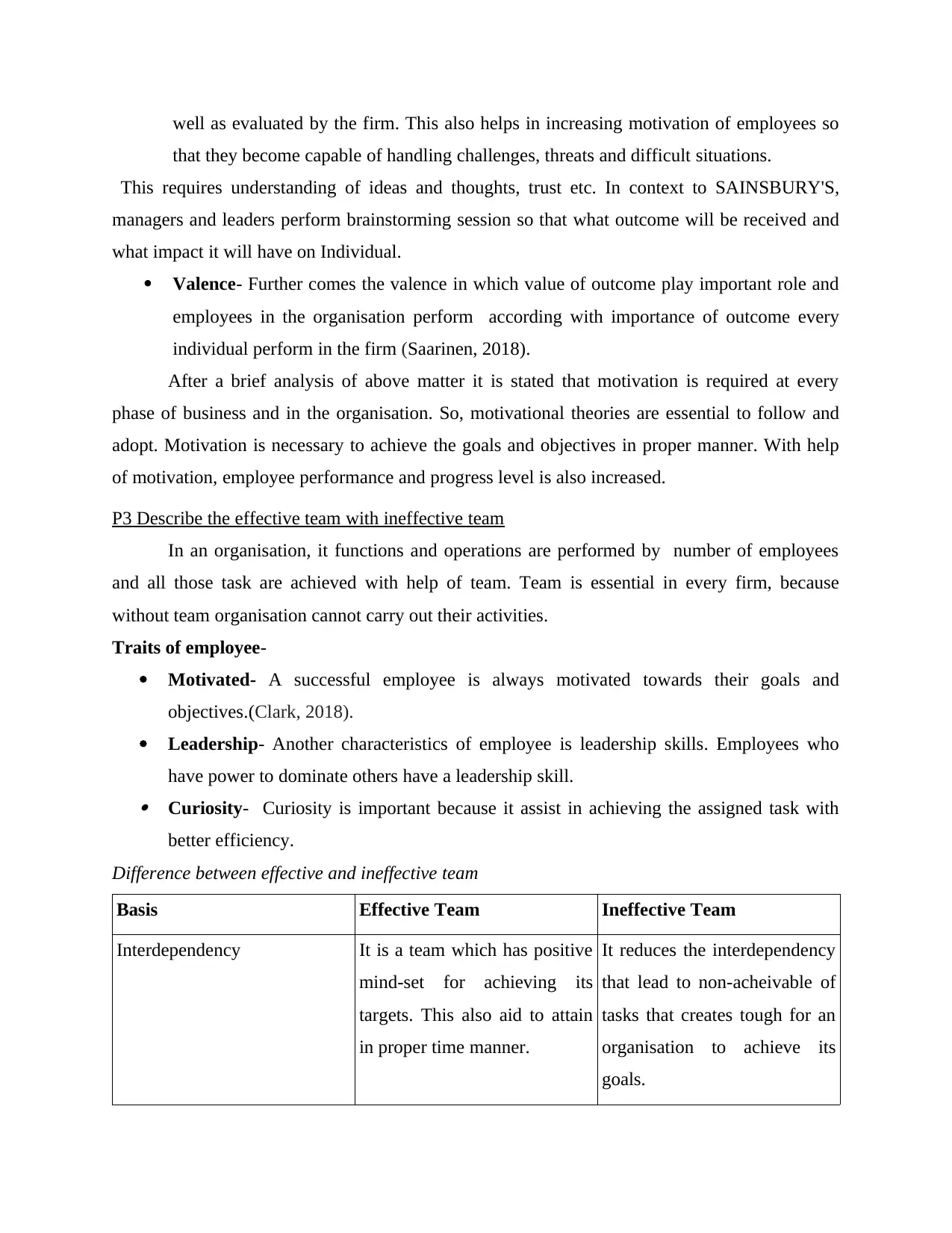
well as evaluated by the firm. This also helps in increasing motivation of employees so
that they become capable of handling challenges, threats and difficult situations.
This requires understanding of ideas and thoughts, trust etc. In context to SAINSBURY'S,
managers and leaders perform brainstorming session so that what outcome will be received and
what impact it will have on Individual.
Valence- Further comes the valence in which value of outcome play important role and
employees in the organisation perform according with importance of outcome every
individual perform in the firm (Saarinen, 2018).
After a brief analysis of above matter it is stated that motivation is required at every
phase of business and in the organisation. So, motivational theories are essential to follow and
adopt. Motivation is necessary to achieve the goals and objectives in proper manner. With help
of motivation, employee performance and progress level is also increased.
P3 Describe the effective team with ineffective team
In an organisation, it functions and operations are performed by number of employees
and all those task are achieved with help of team. Team is essential in every firm, because
without team organisation cannot carry out their activities.
Traits of employee-
Motivated- A successful employee is always motivated towards their goals and
objectives.(Clark, 2018).
Leadership- Another characteristics of employee is leadership skills. Employees who
have power to dominate others have a leadership skill. Curiosity- Curiosity is important because it assist in achieving the assigned task with
better efficiency.
Difference between effective and ineffective team
Basis Effective Team Ineffective Team
Interdependency It is a team which has positive
mind-set for achieving its
targets. This also aid to attain
in proper time manner.
It reduces the interdependency
that lead to non-acheivable of
tasks that creates tough for an
organisation to achieve its
goals.
that they become capable of handling challenges, threats and difficult situations.
This requires understanding of ideas and thoughts, trust etc. In context to SAINSBURY'S,
managers and leaders perform brainstorming session so that what outcome will be received and
what impact it will have on Individual.
Valence- Further comes the valence in which value of outcome play important role and
employees in the organisation perform according with importance of outcome every
individual perform in the firm (Saarinen, 2018).
After a brief analysis of above matter it is stated that motivation is required at every
phase of business and in the organisation. So, motivational theories are essential to follow and
adopt. Motivation is necessary to achieve the goals and objectives in proper manner. With help
of motivation, employee performance and progress level is also increased.
P3 Describe the effective team with ineffective team
In an organisation, it functions and operations are performed by number of employees
and all those task are achieved with help of team. Team is essential in every firm, because
without team organisation cannot carry out their activities.
Traits of employee-
Motivated- A successful employee is always motivated towards their goals and
objectives.(Clark, 2018).
Leadership- Another characteristics of employee is leadership skills. Employees who
have power to dominate others have a leadership skill. Curiosity- Curiosity is important because it assist in achieving the assigned task with
better efficiency.
Difference between effective and ineffective team
Basis Effective Team Ineffective Team
Interdependency It is a team which has positive
mind-set for achieving its
targets. This also aid to attain
in proper time manner.
It reduces the interdependency
that lead to non-acheivable of
tasks that creates tough for an
organisation to achieve its
goals.
Paraphrase This Document
Need a fresh take? Get an instant paraphrase of this document with our AI Paraphraser
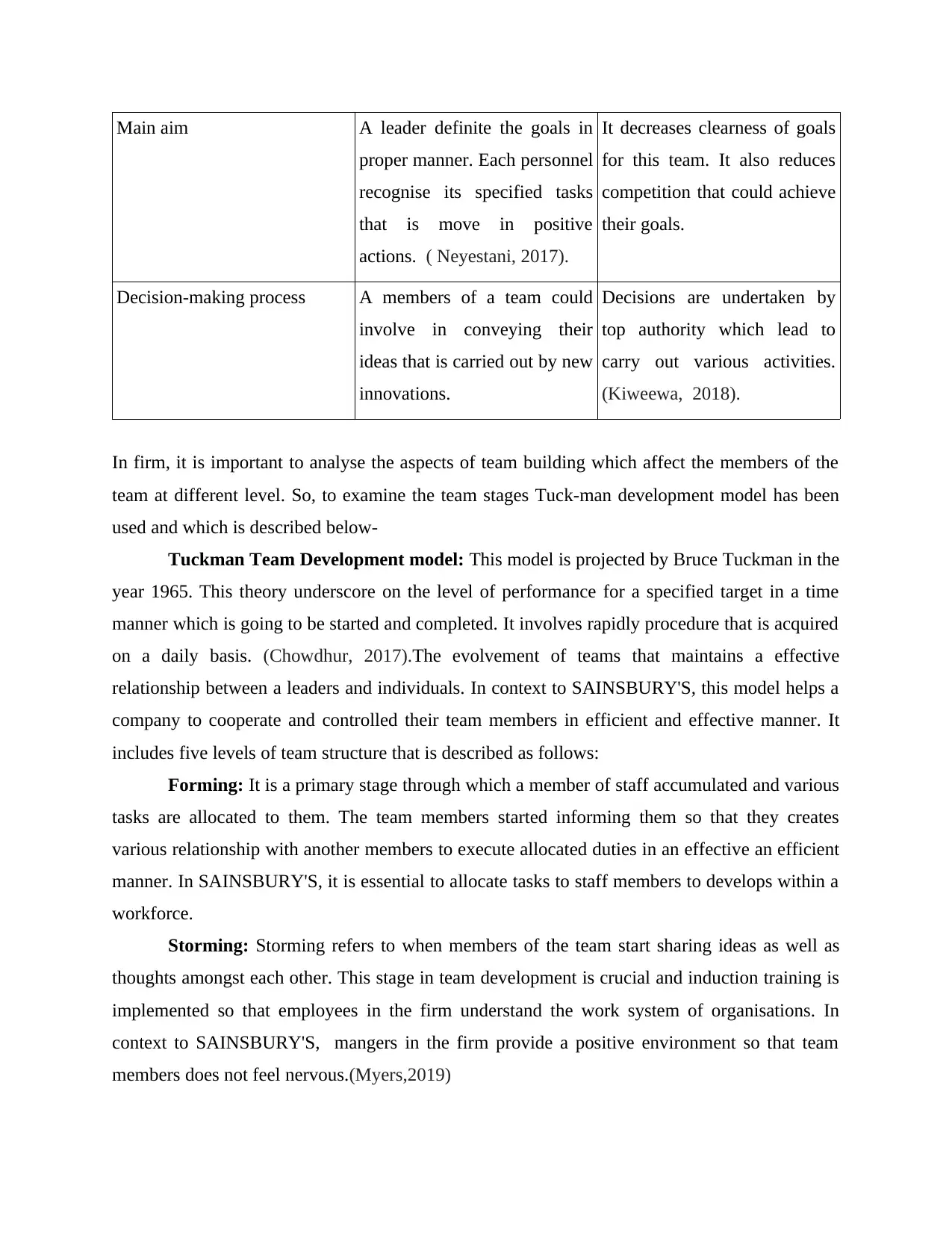
Main aim A leader definite the goals in
proper manner. Each personnel
recognise its specified tasks
that is move in positive
actions. ( Neyestani, 2017).
It decreases clearness of goals
for this team. It also reduces
competition that could achieve
their goals.
Decision-making process A members of a team could
involve in conveying their
ideas that is carried out by new
innovations.
Decisions are undertaken by
top authority which lead to
carry out various activities.
(Kiweewa, 2018).
In firm, it is important to analyse the aspects of team building which affect the members of the
team at different level. So, to examine the team stages Tuck-man development model has been
used and which is described below-
Tuckman Team Development model: This model is projected by Bruce Tuckman in the
year 1965. This theory underscore on the level of performance for a specified target in a time
manner which is going to be started and completed. It involves rapidly procedure that is acquired
on a daily basis. (Chowdhur, 2017).The evolvement of teams that maintains a effective
relationship between a leaders and individuals. In context to SAINSBURY'S, this model helps a
company to cooperate and controlled their team members in efficient and effective manner. It
includes five levels of team structure that is described as follows:
Forming: It is a primary stage through which a member of staff accumulated and various
tasks are allocated to them. The team members started informing them so that they creates
various relationship with another members to execute allocated duties in an effective an efficient
manner. In SAINSBURY'S, it is essential to allocate tasks to staff members to develops within a
workforce.
Storming: Storming refers to when members of the team start sharing ideas as well as
thoughts amongst each other. This stage in team development is crucial and induction training is
implemented so that employees in the firm understand the work system of organisations. In
context to SAINSBURY'S, mangers in the firm provide a positive environment so that team
members does not feel nervous.(Myers,2019)
proper manner. Each personnel
recognise its specified tasks
that is move in positive
actions. ( Neyestani, 2017).
It decreases clearness of goals
for this team. It also reduces
competition that could achieve
their goals.
Decision-making process A members of a team could
involve in conveying their
ideas that is carried out by new
innovations.
Decisions are undertaken by
top authority which lead to
carry out various activities.
(Kiweewa, 2018).
In firm, it is important to analyse the aspects of team building which affect the members of the
team at different level. So, to examine the team stages Tuck-man development model has been
used and which is described below-
Tuckman Team Development model: This model is projected by Bruce Tuckman in the
year 1965. This theory underscore on the level of performance for a specified target in a time
manner which is going to be started and completed. It involves rapidly procedure that is acquired
on a daily basis. (Chowdhur, 2017).The evolvement of teams that maintains a effective
relationship between a leaders and individuals. In context to SAINSBURY'S, this model helps a
company to cooperate and controlled their team members in efficient and effective manner. It
includes five levels of team structure that is described as follows:
Forming: It is a primary stage through which a member of staff accumulated and various
tasks are allocated to them. The team members started informing them so that they creates
various relationship with another members to execute allocated duties in an effective an efficient
manner. In SAINSBURY'S, it is essential to allocate tasks to staff members to develops within a
workforce.
Storming: Storming refers to when members of the team start sharing ideas as well as
thoughts amongst each other. This stage in team development is crucial and induction training is
implemented so that employees in the firm understand the work system of organisations. In
context to SAINSBURY'S, mangers in the firm provide a positive environment so that team
members does not feel nervous.(Myers,2019)
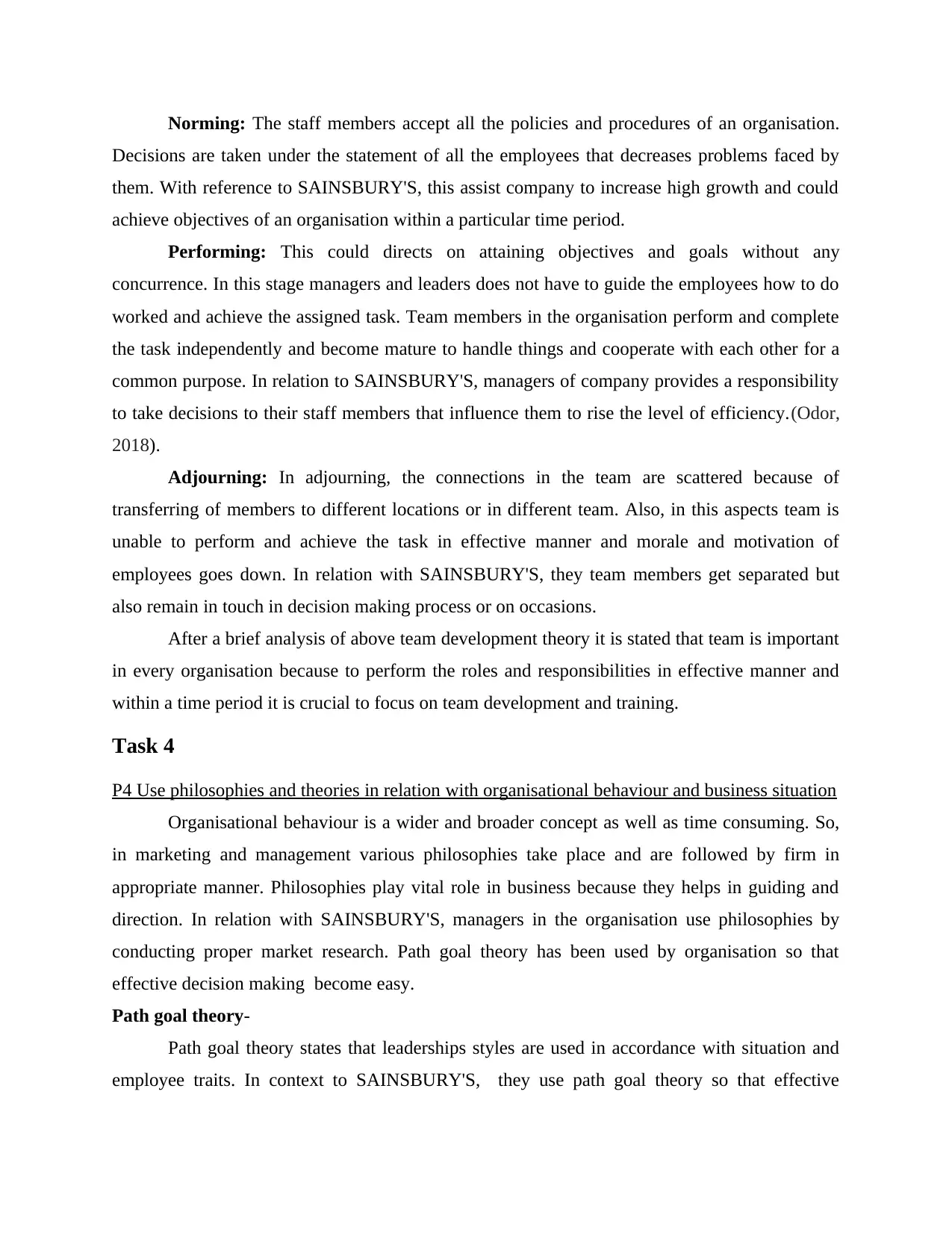
Norming: The staff members accept all the policies and procedures of an organisation.
Decisions are taken under the statement of all the employees that decreases problems faced by
them. With reference to SAINSBURY'S, this assist company to increase high growth and could
achieve objectives of an organisation within a particular time period.
Performing: This could directs on attaining objectives and goals without any
concurrence. In this stage managers and leaders does not have to guide the employees how to do
worked and achieve the assigned task. Team members in the organisation perform and complete
the task independently and become mature to handle things and cooperate with each other for a
common purpose. In relation to SAINSBURY'S, managers of company provides a responsibility
to take decisions to their staff members that influence them to rise the level of efficiency.(Odor,
2018).
Adjourning: In adjourning, the connections in the team are scattered because of
transferring of members to different locations or in different team. Also, in this aspects team is
unable to perform and achieve the task in effective manner and morale and motivation of
employees goes down. In relation with SAINSBURY'S, they team members get separated but
also remain in touch in decision making process or on occasions.
After a brief analysis of above team development theory it is stated that team is important
in every organisation because to perform the roles and responsibilities in effective manner and
within a time period it is crucial to focus on team development and training.
Task 4
P4 Use philosophies and theories in relation with organisational behaviour and business situation
Organisational behaviour is a wider and broader concept as well as time consuming. So,
in marketing and management various philosophies take place and are followed by firm in
appropriate manner. Philosophies play vital role in business because they helps in guiding and
direction. In relation with SAINSBURY'S, managers in the organisation use philosophies by
conducting proper market research. Path goal theory has been used by organisation so that
effective decision making become easy.
Path goal theory-
Path goal theory states that leaderships styles are used in accordance with situation and
employee traits. In context to SAINSBURY'S, they use path goal theory so that effective
Decisions are taken under the statement of all the employees that decreases problems faced by
them. With reference to SAINSBURY'S, this assist company to increase high growth and could
achieve objectives of an organisation within a particular time period.
Performing: This could directs on attaining objectives and goals without any
concurrence. In this stage managers and leaders does not have to guide the employees how to do
worked and achieve the assigned task. Team members in the organisation perform and complete
the task independently and become mature to handle things and cooperate with each other for a
common purpose. In relation to SAINSBURY'S, managers of company provides a responsibility
to take decisions to their staff members that influence them to rise the level of efficiency.(Odor,
2018).
Adjourning: In adjourning, the connections in the team are scattered because of
transferring of members to different locations or in different team. Also, in this aspects team is
unable to perform and achieve the task in effective manner and morale and motivation of
employees goes down. In relation with SAINSBURY'S, they team members get separated but
also remain in touch in decision making process or on occasions.
After a brief analysis of above team development theory it is stated that team is important
in every organisation because to perform the roles and responsibilities in effective manner and
within a time period it is crucial to focus on team development and training.
Task 4
P4 Use philosophies and theories in relation with organisational behaviour and business situation
Organisational behaviour is a wider and broader concept as well as time consuming. So,
in marketing and management various philosophies take place and are followed by firm in
appropriate manner. Philosophies play vital role in business because they helps in guiding and
direction. In relation with SAINSBURY'S, managers in the organisation use philosophies by
conducting proper market research. Path goal theory has been used by organisation so that
effective decision making become easy.
Path goal theory-
Path goal theory states that leaderships styles are used in accordance with situation and
employee traits. In context to SAINSBURY'S, they use path goal theory so that effective
⊘ This is a preview!⊘
Do you want full access?
Subscribe today to unlock all pages.

Trusted by 1+ million students worldwide
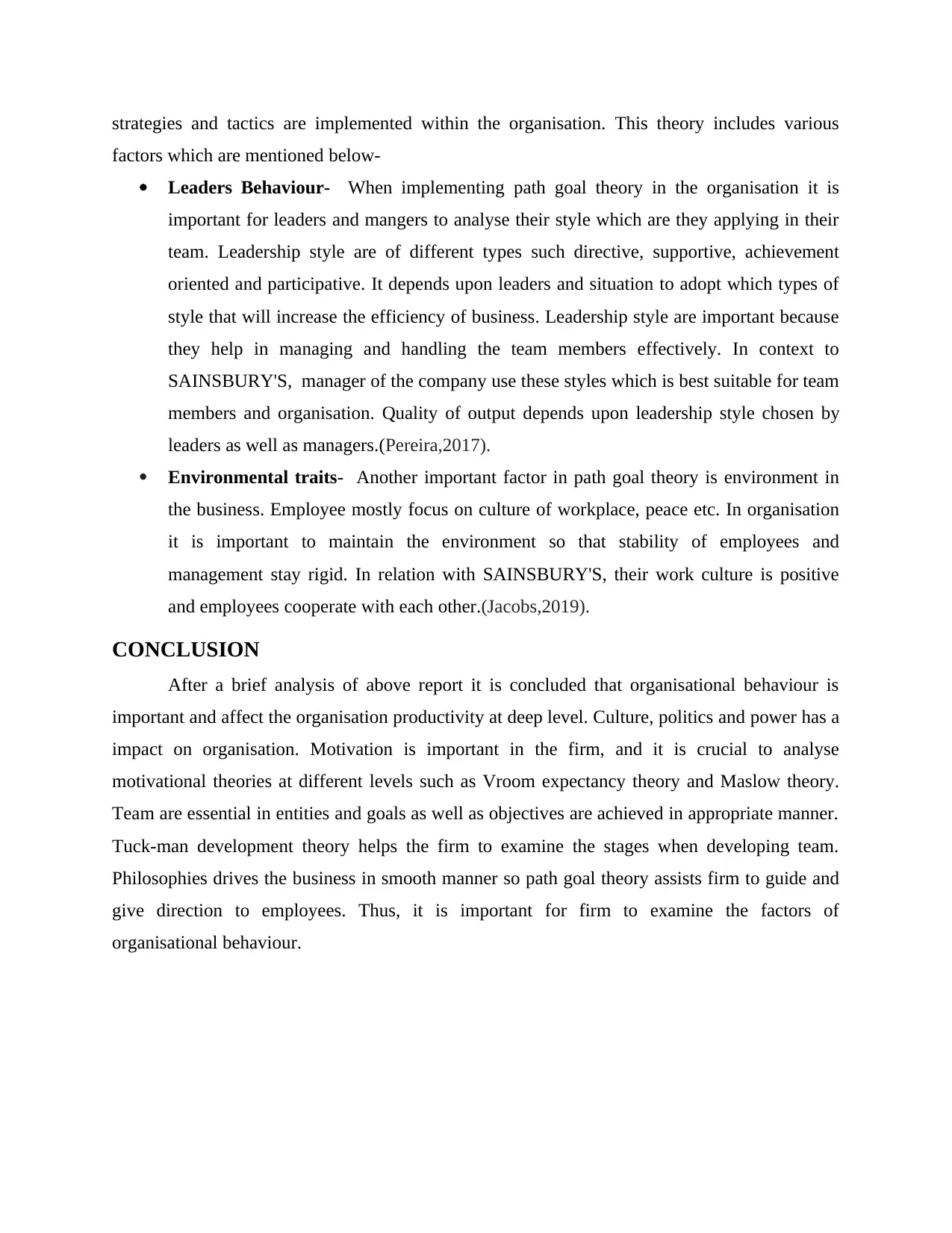
strategies and tactics are implemented within the organisation. This theory includes various
factors which are mentioned below-
Leaders Behaviour- When implementing path goal theory in the organisation it is
important for leaders and mangers to analyse their style which are they applying in their
team. Leadership style are of different types such directive, supportive, achievement
oriented and participative. It depends upon leaders and situation to adopt which types of
style that will increase the efficiency of business. Leadership style are important because
they help in managing and handling the team members effectively. In context to
SAINSBURY'S, manager of the company use these styles which is best suitable for team
members and organisation. Quality of output depends upon leadership style chosen by
leaders as well as managers.(Pereira,2017).
Environmental traits- Another important factor in path goal theory is environment in
the business. Employee mostly focus on culture of workplace, peace etc. In organisation
it is important to maintain the environment so that stability of employees and
management stay rigid. In relation with SAINSBURY'S, their work culture is positive
and employees cooperate with each other.(Jacobs,2019).
CONCLUSION
After a brief analysis of above report it is concluded that organisational behaviour is
important and affect the organisation productivity at deep level. Culture, politics and power has a
impact on organisation. Motivation is important in the firm, and it is crucial to analyse
motivational theories at different levels such as Vroom expectancy theory and Maslow theory.
Team are essential in entities and goals as well as objectives are achieved in appropriate manner.
Tuck-man development theory helps the firm to examine the stages when developing team.
Philosophies drives the business in smooth manner so path goal theory assists firm to guide and
give direction to employees. Thus, it is important for firm to examine the factors of
organisational behaviour.
factors which are mentioned below-
Leaders Behaviour- When implementing path goal theory in the organisation it is
important for leaders and mangers to analyse their style which are they applying in their
team. Leadership style are of different types such directive, supportive, achievement
oriented and participative. It depends upon leaders and situation to adopt which types of
style that will increase the efficiency of business. Leadership style are important because
they help in managing and handling the team members effectively. In context to
SAINSBURY'S, manager of the company use these styles which is best suitable for team
members and organisation. Quality of output depends upon leadership style chosen by
leaders as well as managers.(Pereira,2017).
Environmental traits- Another important factor in path goal theory is environment in
the business. Employee mostly focus on culture of workplace, peace etc. In organisation
it is important to maintain the environment so that stability of employees and
management stay rigid. In relation with SAINSBURY'S, their work culture is positive
and employees cooperate with each other.(Jacobs,2019).
CONCLUSION
After a brief analysis of above report it is concluded that organisational behaviour is
important and affect the organisation productivity at deep level. Culture, politics and power has a
impact on organisation. Motivation is important in the firm, and it is crucial to analyse
motivational theories at different levels such as Vroom expectancy theory and Maslow theory.
Team are essential in entities and goals as well as objectives are achieved in appropriate manner.
Tuck-man development theory helps the firm to examine the stages when developing team.
Philosophies drives the business in smooth manner so path goal theory assists firm to guide and
give direction to employees. Thus, it is important for firm to examine the factors of
organisational behaviour.
Paraphrase This Document
Need a fresh take? Get an instant paraphrase of this document with our AI Paraphraser
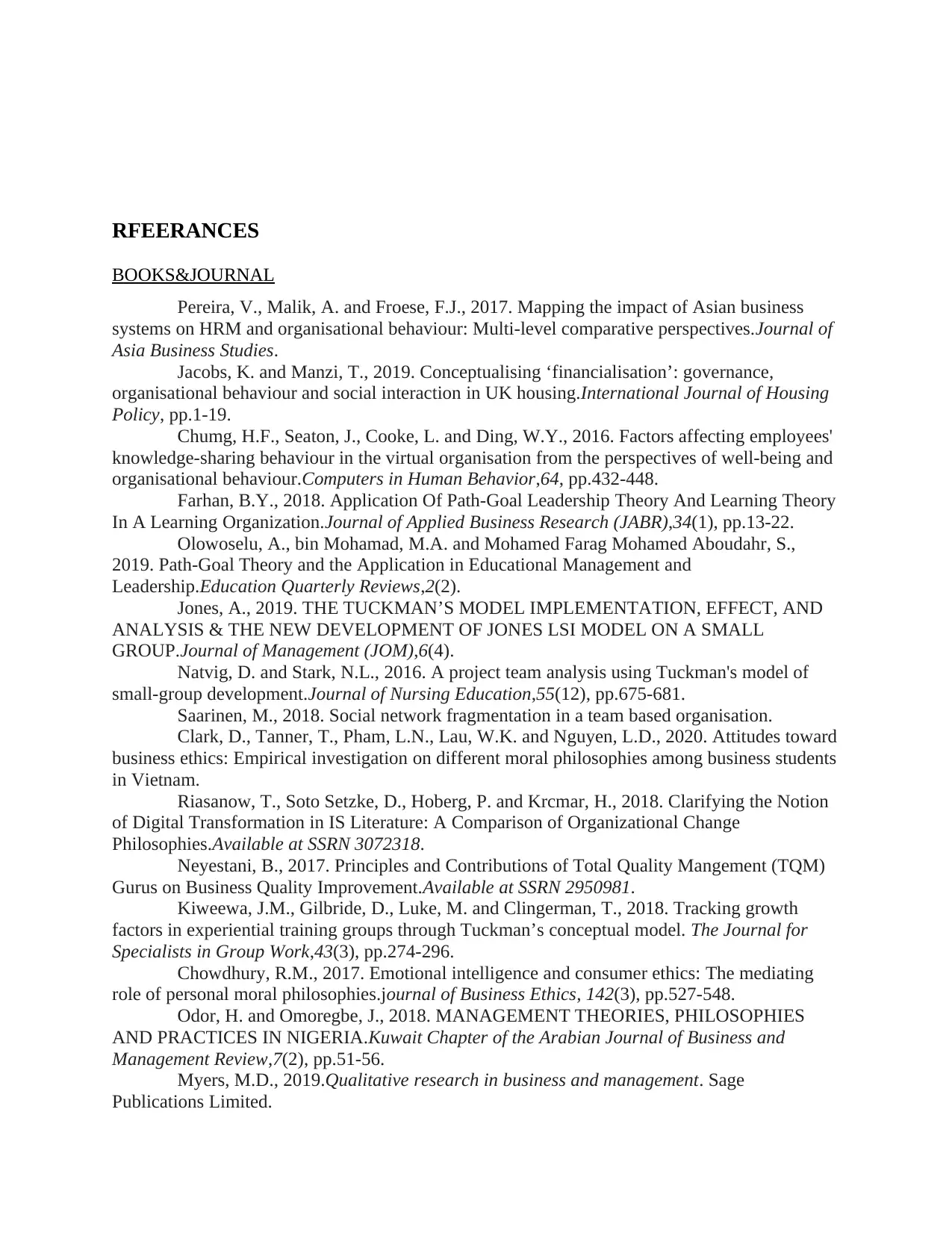
RFEERANCES
BOOKS&JOURNAL
Pereira, V., Malik, A. and Froese, F.J., 2017. Mapping the impact of Asian business
systems on HRM and organisational behaviour: Multi-level comparative perspectives.Journal of
Asia Business Studies.
Jacobs, K. and Manzi, T., 2019. Conceptualising ‘financialisation’: governance,
organisational behaviour and social interaction in UK housing.International Journal of Housing
Policy, pp.1-19.
Chumg, H.F., Seaton, J., Cooke, L. and Ding, W.Y., 2016. Factors affecting employees'
knowledge-sharing behaviour in the virtual organisation from the perspectives of well-being and
organisational behaviour.Computers in Human Behavior,64, pp.432-448.
Farhan, B.Y., 2018. Application Of Path-Goal Leadership Theory And Learning Theory
In A Learning Organization.Journal of Applied Business Research (JABR),34(1), pp.13-22.
Olowoselu, A., bin Mohamad, M.A. and Mohamed Farag Mohamed Aboudahr, S.,
2019. Path-Goal Theory and the Application in Educational Management and
Leadership.Education Quarterly Reviews,2(2).
Jones, A., 2019. THE TUCKMAN’S MODEL IMPLEMENTATION, EFFECT, AND
ANALYSIS & THE NEW DEVELOPMENT OF JONES LSI MODEL ON A SMALL
GROUP.Journal of Management (JOM),6(4).
Natvig, D. and Stark, N.L., 2016. A project team analysis using Tuckman's model of
small-group development.Journal of Nursing Education,55(12), pp.675-681.
Saarinen, M., 2018. Social network fragmentation in a team based organisation.
Clark, D., Tanner, T., Pham, L.N., Lau, W.K. and Nguyen, L.D., 2020. Attitudes toward
business ethics: Empirical investigation on different moral philosophies among business students
in Vietnam.
Riasanow, T., Soto Setzke, D., Hoberg, P. and Krcmar, H., 2018. Clarifying the Notion
of Digital Transformation in IS Literature: A Comparison of Organizational Change
Philosophies.Available at SSRN 3072318.
Neyestani, B., 2017. Principles and Contributions of Total Quality Mangement (TQM)
Gurus on Business Quality Improvement.Available at SSRN 2950981.
Kiweewa, J.M., Gilbride, D., Luke, M. and Clingerman, T., 2018. Tracking growth
factors in experiential training groups through Tuckman’s conceptual model. The Journal for
Specialists in Group Work,43(3), pp.274-296.
Chowdhury, R.M., 2017. Emotional intelligence and consumer ethics: The mediating
role of personal moral philosophies.journal of Business Ethics, 142(3), pp.527-548.
Odor, H. and Omoregbe, J., 2018. MANAGEMENT THEORIES, PHILOSOPHIES
AND PRACTICES IN NIGERIA.Kuwait Chapter of the Arabian Journal of Business and
Management Review,7(2), pp.51-56.
Myers, M.D., 2019.Qualitative research in business and management. Sage
Publications Limited.
BOOKS&JOURNAL
Pereira, V., Malik, A. and Froese, F.J., 2017. Mapping the impact of Asian business
systems on HRM and organisational behaviour: Multi-level comparative perspectives.Journal of
Asia Business Studies.
Jacobs, K. and Manzi, T., 2019. Conceptualising ‘financialisation’: governance,
organisational behaviour and social interaction in UK housing.International Journal of Housing
Policy, pp.1-19.
Chumg, H.F., Seaton, J., Cooke, L. and Ding, W.Y., 2016. Factors affecting employees'
knowledge-sharing behaviour in the virtual organisation from the perspectives of well-being and
organisational behaviour.Computers in Human Behavior,64, pp.432-448.
Farhan, B.Y., 2018. Application Of Path-Goal Leadership Theory And Learning Theory
In A Learning Organization.Journal of Applied Business Research (JABR),34(1), pp.13-22.
Olowoselu, A., bin Mohamad, M.A. and Mohamed Farag Mohamed Aboudahr, S.,
2019. Path-Goal Theory and the Application in Educational Management and
Leadership.Education Quarterly Reviews,2(2).
Jones, A., 2019. THE TUCKMAN’S MODEL IMPLEMENTATION, EFFECT, AND
ANALYSIS & THE NEW DEVELOPMENT OF JONES LSI MODEL ON A SMALL
GROUP.Journal of Management (JOM),6(4).
Natvig, D. and Stark, N.L., 2016. A project team analysis using Tuckman's model of
small-group development.Journal of Nursing Education,55(12), pp.675-681.
Saarinen, M., 2018. Social network fragmentation in a team based organisation.
Clark, D., Tanner, T., Pham, L.N., Lau, W.K. and Nguyen, L.D., 2020. Attitudes toward
business ethics: Empirical investigation on different moral philosophies among business students
in Vietnam.
Riasanow, T., Soto Setzke, D., Hoberg, P. and Krcmar, H., 2018. Clarifying the Notion
of Digital Transformation in IS Literature: A Comparison of Organizational Change
Philosophies.Available at SSRN 3072318.
Neyestani, B., 2017. Principles and Contributions of Total Quality Mangement (TQM)
Gurus on Business Quality Improvement.Available at SSRN 2950981.
Kiweewa, J.M., Gilbride, D., Luke, M. and Clingerman, T., 2018. Tracking growth
factors in experiential training groups through Tuckman’s conceptual model. The Journal for
Specialists in Group Work,43(3), pp.274-296.
Chowdhury, R.M., 2017. Emotional intelligence and consumer ethics: The mediating
role of personal moral philosophies.journal of Business Ethics, 142(3), pp.527-548.
Odor, H. and Omoregbe, J., 2018. MANAGEMENT THEORIES, PHILOSOPHIES
AND PRACTICES IN NIGERIA.Kuwait Chapter of the Arabian Journal of Business and
Management Review,7(2), pp.51-56.
Myers, M.D., 2019.Qualitative research in business and management. Sage
Publications Limited.

⊘ This is a preview!⊘
Do you want full access?
Subscribe today to unlock all pages.

Trusted by 1+ million students worldwide
1 out of 15
Related Documents
Your All-in-One AI-Powered Toolkit for Academic Success.
+13062052269
info@desklib.com
Available 24*7 on WhatsApp / Email
![[object Object]](/_next/static/media/star-bottom.7253800d.svg)
Unlock your academic potential
Copyright © 2020–2025 A2Z Services. All Rights Reserved. Developed and managed by ZUCOL.





